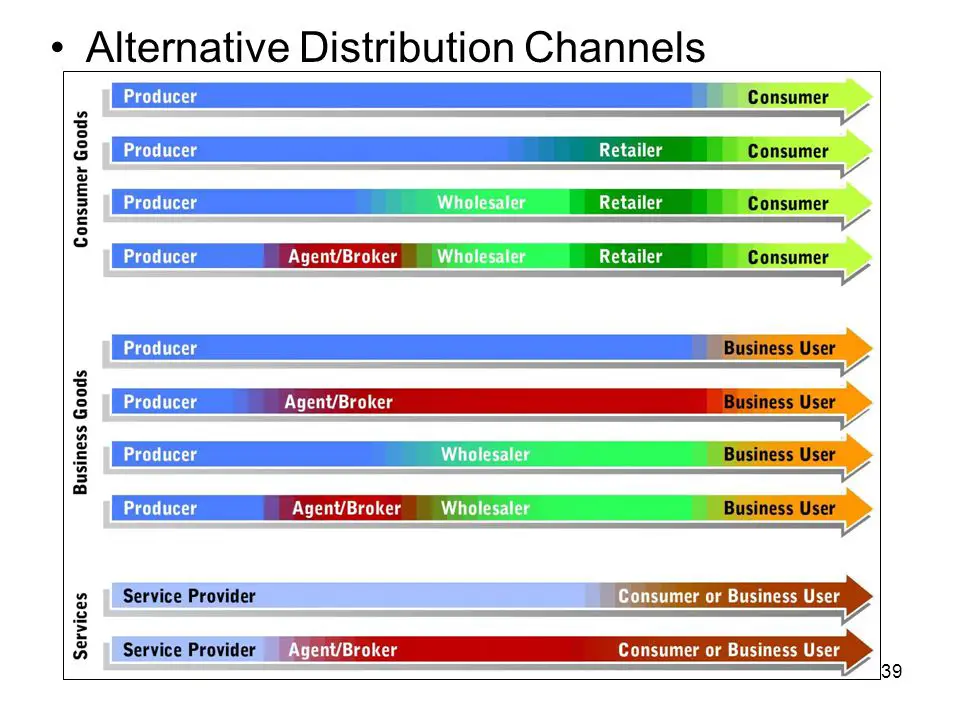Physical Distribution Channel
Physical Distribution Channels and Their Types
 Photo courtesy of FlowspaceOpens in new window
Photo courtesy of FlowspaceOpens in new window
Amongst many decisions, a crucial, and often challenging, decision that should be taken by logistics executives is determining a product’s distribution channelsOpens in new window—the alternative ways or path through which a product reaches its market. |
In contrast to some decisions, such as advertising and promotion programs, which can be readily changed by companies, distribution channel decisions tend to be hard to change because they usually involve long-term and often strong commitments to intermediariesOpens in new window, including brokers, wholesalers, and retailers.
Therefore, in determining distribution channels, many different factors of today’s and tomorrow’s business environment should be taken into account by companies.
Generally, there are two types of distribution channels: physical and trading or transaction.
As the name suggests, a physical distribution channel deals with the physical aspects of a product distribution, including all the methods, means, and entities through which the product is distributed from the supplier’s or manufacturer’s outlet to the end user.
Through the physical channels, products are transferred physically to reach their designated destination, which could be a factory outlet, a retail store, or even a customer’s house.
Trading or transaction channels are concerned with the nonphysical aspects of distributing products from their point of origin to their of consumption.
When a product transfers through distribution channels, the ownership of the product is transferred along with its physical movement. The sequence of negotiation and the exchange of product’s ownership are the distribution aspects that the trading or transaction channel is concerned with.
Types of Physical Distribution Channels
There exist several alternative physical distribution channels that can be used separately or in combination with each other to bring a product or group of products to the end user.
Distribution channelsOpens in new window contain different numbers of intermediary levels that are referred to as the length of those channels.
 Figure X-1. Alternative Distribution Channels
Figure X-1. Alternative Distribution Channels
|
Each member of a distribution channel that has an impact on transferring the product and its ownership to the ultimate user is considered to be a channel level. Therefore, both the producer and the consumer are members of every distribution channel. Figure X-1 shows the main alternative channels of distribution.
- Producer Direct to Consumer
The direct-marketing channel is the simplest and shortest distribution channel, and it has no intermediary levels (channel 1). This channel can be a part of a direct-selling marketing strategy, which consists of a producer selling directly to the final consumer.
Products that are customized for specific customers and those ordered through catalog or newspaper advertising are examples of goods commonly distributed through this channel. Also, customers who now shop from home, thanks to the Internet, are other users of this channel. Moreover, products composed of data, such as text, software, music, and films, can be directly distributed from computer to computer.
- Producer to Retailer to Consumer
In contrast to channel 1, the remaining channels contain one or more intermediary levels, which are referred to indirect-marketing channels.
In channel 2a, producers deliver their own goods directly to large retail stores, which then sell these products to end users. In general, this channel is suitable for manufacturer distributing their products in TL size.
Channel 2b is quite similar to channel 2a, but producers deliver their own products in large shipments to distribution centers, which could be one central distribution center (CDC) or a number of regional distribution centers (RDCs).
The products are then broken down into smaller orders that are transported to retailers on the manufacturer’s own means.
The only difference between channels 2b and 2c is that in the latter products from several suppliers are delivered to distribution centers run by retail organizations. The different types of products are consolidated in these centers and then delivered to retail stores in full truck loads, using the retailers’ own vehicles or those of third-party providers.
Channel 3 has two intermediary levels. These intermediaries are retailers along with wholesalers in channels 3a and 3b, and third-party distribution service providers and brokers in channels 3c and 3d, respectively.
- Producer to Wholesaler to Retailer to Consumer
The use of wholesalers as intermediaries is popular whenever the limited lines and financial resources of some small manufacturers would not allow them to distribute their products on their own; therefore, they rely on wholesalers’ specialized distribution services, which supply a great number of retailers.
Channel 3a is also suitable for those small retailers that cannot afford to buy large quantities of products. Wholesalers use their own delivery vehicles and distribution centers, and they benefit from the price advantage of buying bulk shipments from suppliers.
Channel 3b illustrates the concept of cash-and-carry organizations. In contrast to traditional wholesaling, this channel consists of several small retailers that are collecting their own demands from wholesalers.
As the order quantities of small retailers and shops are very small, producers, suppliers, and even wholesalers do not deliver their demands directly to their stores; as a result, the use of cash-and-carry organizations tends to increase nowadays.
- Producer via 3PL or Broker to Retailer to Consumer
This involves third-party distribution service providers and brokers and the other intermediaries supplying manufacturers’ products to retail stores. The use of 3PL providers has increased as the distribution of products became more expensive and more complicated.
The constantly changing legislation and restrictive rules and regulations on product distribution can justify the growing need for third-party distribution service providers, companies that are experts in distribution and warehousing, as well as other logistics functions.
Although most of the 3PLs provide general distribution services, there are companies offering services for special types of products such as small parcels carriers that provide “specialist” services for products in the form of small parcels (see channel 3c).
Brokers or agents are independent intermediaries that bring buyers and sellers together. Brokers are not often fully concerned with physical distribution of products, and they never take title to goods. They are more concerned with products’ marketing, and thus they may be considered as trading or transaction channels sometimes (see channel 3).
- Producer via Broker to Wholesaler to Retailer to Consumer
Channel 4 represents a physical distribution channel with three intermediaries. This channel is similar to previous channels except that producers are represented by brokers who deliver their products through wholesalers.
In general, a broker may represent either a manufacturer or a wholesaler by searching markets for its goods or by seeking supply source for its orders.
Distribution channels with more than three intermediary levels can be imagined, though they are not common channels. As the number of intermediary levels increases, the channel becomes more complex and the producer’s control over the product flows decreases.
The distribution channels illustrated in Figure X1 are the main alternatives of consumer marketing channels; however, distribution channels for industrial goods have quite the same structures as explained in the following sections.
Business-to-Business Channels
The first industrial distribution channel a business marketer can use is the direct-marketing channel, which is quite similar to channel 1, except the final consumer is replaced with a business customer.
Most industrial goods such as raw materials, equipment, and component parts are sold through this business channel. There is no need for wholesalers or other intermediaries in this channel because the goods are sold in large quantities.
In the case of small accessories, producers sell their products to wholesalers or industrial distributors, which in turn sell them to business customers. Brokers and sales agents are also represented by independent intermediaries called manufacturers’ representatives to market their products to large wholesalers or to final business customers.
Any one or more of the above-mentioned alternative distribution channels might be used by manufacturers to make their products available to final customers. An individual producer may choose different marketing channels with respect to its different types of products or customers.
- J.C. Johnson, D.F. Wood, D.L. Wardlow, P.R. Murphy, Contemporary Logistics, seventh ed., Prentice Hall, Upper Saddle River, NJ, 1999, pp. 1 – 21.
- A. Rushton, P. Crouche, P. Baker, The Handbook of Logistics and Distribution Management, third ed., Kogan Page, London, 2006.
- S.C. Ailawadi, R. Singh, Logistics Management, Prentice Hall of India, New Delhi, 2005.
- R.H. Ballou, Business Logistics/Supply Chain Management: Planning, Organizing, and Controlling the Supply Chain, fifth ed., Pearson-Prentice Hall, Upper Saddle River, NJ, 2004.
- J.R. Stock, D.M. Lambert, Strategic Logistics Management, fourth ed., Irwin McGraw-Hill, New York, 2001.
- G. Ghiani, G. Laporte, R. Musmanno, Introduction to Logistics Systems Planning and Control, John Wiley & Sons, NJ, 2004, pp. 6 – 20.
- M. Hugos, Essentials of Supply Chain Management, John Wiley & Sons, Hoboken NJ, 2003, pp. 1 – 15.
- H.T. Lewis, J.W. Culliton, J.D. Steel, The Role of Air Freight in Physical Distribution, Division of Research, Graduate School of Business Administration, Harvard University, Boston, MA, 1956, p. 82.
- D. Riopel, A. Langevin, J.F. Campbell, The network of logistics decisions, in: A. Langevin, D. Riopel (Eds.), Logistics Systems: Design and Optimization, Springer, New York, 2005, pp. 12–17.
- M. Browne, J. Allen, Logistics of food transport, in: R. Heap, M. Kierstan, G. Ford (Eds.) Food Transportation, Blackie Academic & Professional, London, 1998, pp. 22–25.
- J. Drury, Towards More Efficient Order Picking, IMM Monograph No. 1, The Institute of Materials Management, Cranfield, 1988.

